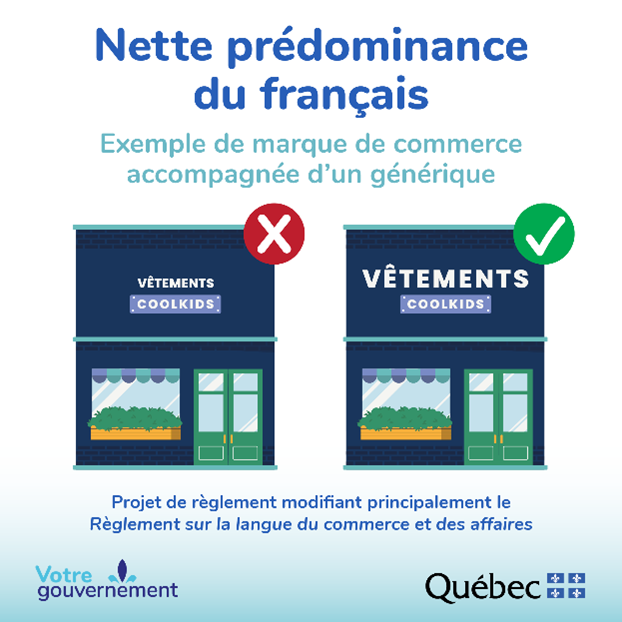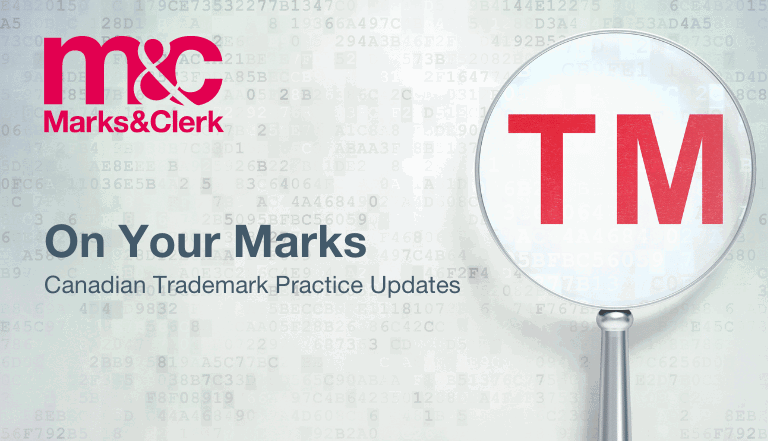Quebec is Canada’s French speaking province, and as a general rule, products, commercial documents as well as public signs and commercial advertising in Quebec must abide by the Charter of the French Language (the “Charter”). At the administrative level, the Charter is enforced by the Office québécois de la langue française (the “OQLF”).
In Quebec, under the Charter, all inscriptions (e.g. markings) on a product, or its packaging and labels (i.e. on its container or wrapping, or any document or object supplied with it) must appear in French, and no other language may appear in greater prominence than French or be available on more favourable terms. Further, on public signage and posters that are visible from the exterior of a premises, a trademark or a business name in a language other than French must be accompanied by French text that is “markedly predominant”. Other advertising and marketing materials, including websites, social media, as well as catalogues and brochures, must also be written in French, and if written in French and in another language, the French version must be no less prominent than, and accessible on terms that are at least as favourable as other languages.
There are a few exceptions, including one for non-French trademarks (the “trademark exception”), which may be drawn up, even partially, only in a language other than French where no corresponding French version appears on the Canadian Trademarks Register.
Since 2022, brand owners have been closely monitoring upcoming changes to the trademark exception and preparing to comply.
As discussed in this article, brand owners now have greater clarity on French language requirements for product inscriptions and advertising and marketing materials, though compliance questions remain.
Product Inscriptions
In Quebec, under the Charter, all inscriptions (e.g markings) on a product, or its packaging and labels (i.e. on its container or wrapping, or any document or object supplied with it) must appear in French, and no other language may appear in greater prominence than French or be available on more favourable terms.
As noted, the trademark exception permits non-French trademarks to appear even partially, only in a language other than French where no corresponding French version appears on the Canadian Trademarks Register.
Brand Owners Benefit from Expansion of the Trademark Exception from “Registered” to “Recognized” Trademarks
Prior to 2022, the trademark exception allowing brand owners to use non-French trademarks covered “recognized” trademarks. There was some ambiguity regarding what was considered a “recognized” trademark under the previous regime. The OQLF had traditionally considered that for a trademark to benefit from the “recognized” trademark exception, it must be registered with the Canadian Intellectual Property Office (“CIPO”). Yet, courts held that the “recognized” trademark exception applied to both registered and non-registered trademarks. Further, under the previous regime, there was no requirement to translate any non-French generic or descriptive terms that were included in the trademark.
In 2022, the Charter was amended to explicitly restrict the trademark exception to “registered” trademarks, materially narrowing the trademark exception, and excluding common law and applied-for marks from the exception. Draft regulations were introduced in January 2024 expanding the definition of “registered” trademarks to include trademark applications pending at CIPO.
In June 2024, the Quebec government issued the final amended version of the Regulation respecting the language of commerce and business (the “Regulations”) expanding the trademark exception beyond “registered” trademarks to include “recognized” trademarks. Though the Regulations do not provide a definition of “recognized” trademark, the OQLF has defined the term on its website to include (1) registered marks and (ii) common law marks. So, while the Charter continues to provide that “registered” trademarks benefit from the trademark exception, through the Regulations, the Quebec government has expanded the trademark exception to again extend to “recognized” trademarks. It is important to note that the trademark exception is only available if there is no corresponding registration or pending application for the French version of the mark in Canada.
Many brand owners have welcomed the expansion of the trademark exception to ”recognized” trademarks. However, uncertainty remains, including for newly adopted marks, and to what extent a trademark owner may rely on a pending application to benefit from the trademark exception before common law rights may have arisen based on use of the mark in Canada. In particular, as there is no longer a reference to “trademark applications” in the Regulations, there is a live question related to whether applied-for marks that have not been used and have no reputation or goodwill in Canada, will qualify as “common law” marks.
Brand Owners Must Translate Generic and Descriptive Terms in “Recognized” Trademarks
Brand owners relying on the “recognized” trademark exception will nevertheless be required to translate into French certain terms included in non-French marks on a product.
In 2022, the Charter was amended to require that if a trademark is partially composed of a non-French “generic term or a description of the product”, that term or description must appear in French on the product or on a medium permanently attached to it.
A generic term refers to one or more words describing the nature of the product. A description refers to one or more words describing the characteristics of a product. Generic terms and descriptions exclude the name of the enterprise and the name of the product as sold, as well as designations of origin and distinctive names of a cultural nature.
The OQLF has provided examples to help direct brand owners on the approach to translation, including:

The Regulations do not set out the required size or prominence of the French translations of generic/descriptive terms. However, the Charter provides that inscriptions in other languages may be given no greater prominence than French inscriptions nor be available on more favourable terms.
While the Regulations provided welcome clarity that product names included in marks need not be translated, and that geographical indications, for example, are covered by the exception, it remains to be seen how the OQLF will interpret and apply the requirement to translate generic terms and descriptions in practice.
Another possible issue that might be challenging to navigate is how to reconcile the translation requirement for generic terms or product descriptions with descriptive trademarks that have acquired distinctiveness and have obtained registration under section 12(3) of the Canadian Trademarks Act – though a clearly descriptive term would likely fall under definitions of generic terms and product descriptions under the Charter and Regulations, the impact of secondary meaning remains to be seen.
Exception for Permanent Engravings on Products
There is an exception for permanent inscriptions on a product, in particular, for inscriptions that are engraved, baked or inlaid on a product itself, riveted or welded into it, or embossed on it, in a permanent manner. Provided the product was manufactured outside Quebec, such non-French inscriptions do not need to be translated into French unless the inscription concerns safety. Safety information must be translated in French and appear on the product or accompany it in a permanent manner.
For now, permanent inscriptions that provide information on the use of a product remain exempt, provided they do not concern safety. This puts to rest immediate concerns over the need to translate permanent inscriptions that convey information necessary for use of the product into French.
Exterior Public Signage
While the trademark exception also extends to public signage, posters and commercial advertising, there are separate rules that apply. For example, public signage and posters that are visible from the exterior of a premises must be accompanied by French text that is “markedly predominant”. The Regulations provide that the French text on exterior signage must have a much greater visual impact than text in another language by meeting the following two conditions:
- The space allotted to French text is at least twice as large as the space for non-French language.
- French text must be equivalently legible to text in another language and permanently visible.
Below is an image that the OQLF provided for guidance:

Commercial Publications
According to the Charter, any “commercial publication” must be written in French. A commercial publication may also be written both in French and in another language, provided that the French version is accessible on terms that are at least as favourable.
According to the Charter, the commercial publications covered by these rules include “catalogues, brochures, folders, commercial directories, order forms and any other document of the same nature that is available to the public”. According to the OQLF’s administrative position, websites and social media are also considered “commercial publications” under the Charter.
Unlike product inscriptions, public signage and commercial advertising, the Charter does not provide any exception for “registered trademarks” used in commercial publications, but the original Regulations provided the exception for “recognized” trademarks. This exception remains unchanged and continues to apply.
Possible Compliance Strategies
A Canadian trademark registration may not be necessary to benefit from the trademark exception in Quebec if common law rights can be established. When relying on common law rights, it would be prudent to ensure that (i) marks are used with the “MC” symbol (or “TM/MC” which is bilingual) which stands for “marque de commerce”, (ii) descriptive or generic terms in a non-French mark (other than the exceptions provided for under the Regulations such as the name of the product as commercialised like “BESTSOAP” in the above example) otherwise appear in French on the product or on a medium permanently attached to it, and (iii) where possible, present the non-French mark in a distinctive design format.
While registration may not be required, it may still be advisable to file trademark applications in certain circumstances. For example, for new marks that are inherently distinctive but do not yet have reputation in Canada, it may be advisable to file trademark applications to be positioned to rely on the mark being a “recognized” trademark based on the Canadian trademark application in combination with scant use and limited reputation in Canada. Likewise, filing a trademark application may be prudent in cases where the mark is highly suggestive but there is a reasonable chance of securing registration. If, however, the mark is closer to being clearly descriptive (such that the chance of registration is low), and there is no (or insufficient) basis to establish common law rights in Canada, the situation may be more precarious. It remains to be seen what position the OQLF will take if CIPO refuses registration. To the extent new applications are contemplated for marks that may be considered clearly descriptive, and registration is unlikely, it may be preferable to file for distinctive design or composite word versions of the mark to enhance the prospect of registration. In such cases it may be prudent to hold on filing word mark applications unless/until acquired distinctiveness can be shown, and in the interim, to use the trademark, along with the MC or TM/MC symbol until that is possible, and to ensure that the product, its packaging or wrapping otherwise displays French text that reflects the descriptive/generic meaning.
Generally, to benefit from the “recognized” trademark exception, it is not recommended to file any French version of the trademark with CIPO.
If there is uncertainty, while there may be strategies to lower risks, it may be prudent to translate a non-French mark, including any possible generic or descriptive information contained in the mark into French. This would guard against both enforcement by the OQLF, as well as the risk of a private action being initiated. Demonstrating respect for the French language may also generally gain favour among French speakers in Canada.
Compliance by June 1, 2025, with a phase-out period to sell off by June 1, 2027
The above new requirements come into force on June 1, 2025. Until June 1, 2027, products, packaging and labels that do not comply with the new requirements can still be sold in Quebec, provided that they were manufactured no later than June 1, 2025, and no French version of the mark was registered as of June 26, 2024. An additional grace period is provided for products subject to certain labelling rules.



